Steven Sandor's Blog, page 105
March 3, 2015
On a big night for soccer, we should celebrate Sadiki’s goal more vociferously than Porter’s
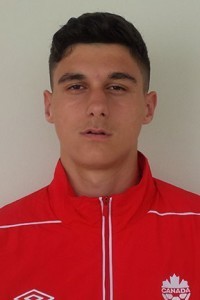
Kosovar Sadiki
So, on a Tuesday night packed with action for the Canadian soccer supporter — what was the most important moment?Was it a last-gasp goal from Cameron Porter, or a second-half marker from Kosovar Sadiki?
Porter’s injury time equalizer was what the Montreal Impact needed to advance in the CONCACAF Champions League at the expense of Mexican side, Pachuca. When it looked like the Impact would once again be foiled by a Mexican side at the quarter-final stage, the rookie-turned-super-sub notched the marker that turned the Big O into a big party.
Meanwhile, in front of about 37,995 fewer spectators in the stands in Honduras, Sadiki scored the goal to give his Canadian U-17 side a precious 3-2 win over Costa Rica. The win moved Canada to two wins in two matches at the CONCACAF U-17 Championships; to have any shot at the qualifying for the U-17 World Cup, the Canadians have to finish in the top three in their group. And that means the Canadians will need to finish ahead of either Mexico, Panama or Costa Rica. If the Canadians finish atop their group, then they get a direct route to the World Cup, with no worry of a crossover playoff.
Let’s face it; after the U-20 team flamed out at their age group’s CONCACAF playdowns — and with the overall malaise that has gripped Canadian men’s soccer for, well, at least five World Cup qualifying cycles, we’ve grown accustomed to not expecting much from our national teams. Sadiki’s goal might end up being fool’s gold; but, for one hopeful night, it’s a light at the end of dark, dreary tunnel.
Now, let’s get back to Porter’s goal. A wonderful moment in Montreal sports, but definitely not a milestone in Canadian sports. In 2009, when more than 55,000 jammed into the Big O to watch the then-second-division Impact play Santos Laguna in the CCL quarterfinals, there was a lot to admire about that group. On that day, four Canadians started. Sure, there were Americans and other foreigners on the team, but with John Limniatis coaching, and local players on the pitch, there was no shaking the Canadian — no, the Quebecois — heart of this team. You might have loved that team, you might have hated that team, but with the passion of Canadian players like Sandro Grande and Nevio Pizzolitto, you had to admit that the team had a soul.
Fast forward six years, and this Impact team is about as Canadian as Kentucky Fried Chicken. The fleur-de-lis on the team’s crest only calls attention to the fact that no Quebecers (or Canadians raised outside of Quebec) played in either the first leg at Pachuca or the second leg at Olympic Stadium. Sure, the Impact is now an MLS side, but it’s no longer an us-against-the-world outfit with a uniquely Quebec heart; it’s a bunch of Americans and Europeans who wear a fleur-de-lis that has become about as meaningful as a New Orleans Saints helmet.
Sure, this Impact team of 2015 could have a couple of more shocks in it; but when it comes to likeability, when it comes to soul, it has barely a fraction of what the 2009 team had. Sure, 38,000-plus came out to watch Porter score against Pachuca; but more than 55,000 came out to watch the Impact win that first leg against Santos Laguna in 2009, before the famed late-second-half collapse in the second leg in Mexico.
Porter’s goal could mean something for MLS, but it means zero for the fabric of Canadian soccer. This Impact team has success in CCL — even though it could be dashed if the MLS Players Union makes the call to strike and a semifinal is decided by forfeit. But, in exchange for that success, is this a team without a soul?
READ THE NEW ISSUE OF PLASTIC PITCH! CANADIAN SOCCER. CANADIAN STORIES. OUT NOW FOR APPLE and ANDROID DEVICES.
Or, visit the PLASTIC PITCH SHOPIFY STORE!
Herdman on CNWT: “There’s not too many cards left up our sleeves”
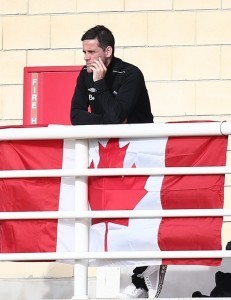
John Herdman
We’re now at the stage of the poker game where it’s time to call. We’ve gone through the bets, the bluffs and the folds.As Canada’s national women’s team prepares for the Cyprus Cup — its final tournament before the Women’s World Cup, coach John Herdman knows he has very few secrets left to keep. He knows he has to have his team playing to its strengths — and that means there’s very little left to hold back and to keep those scouting for their World Cup opponents guessing.
“You can’t hide everything,” Herdman said in a conference call on Tuesday. “You’ve got to do what you do better than the other teams.
“There’s not too many cards left up our sleeves.”
Canada begins group-stage play on Wednesday. Scotland, not a World Cup side, will provide the opposition. Then it’s South Korea, a World Cup qualifier that won’t be in Canada’s WWC first-round group, and then another non-World Cup side, Italy.
Herdman said that if Canada gets into a Cyprus Cup crossover playoff with the Netherlands, he might alter things a bit, as the Dutch are in Canada’s World Cup group. Really, of all the teams Herdman will want to scout at the Cyprus Cup, the Dutch are at the top of the list.
He said the Netherlands is a perfect example of a former “tier three” women’s soccer nation that is breaking through. And he wants a first-hand look at Dutch teenager Vivianne Miedema.
“It looks like she was born to score goals,” said Herdman.
That might be an understatement. In the UEFA playoff against Italy, which qualified the Dutch for the World Cup, Miedema scored all three of her team’s goals over the two legs. She’s scored five times in 11 matches for Bayern Munich so far this season. As a 17-year-old, she scored 41 times in 26 matches for Dutch side, Heerenveen.
Even though Herdman admitted he’d already put a lot of his cards on the table, he said that tactically, his Canadian side will still need to be able to surprise a lot of opponents. When asked about what he thought his team’s shape would be at the Cyprus Cup or at the Women’s World Cup, he simply answered that Canada’s success would depend on it “being the most organized team.”
But, is there still time for a player to get into the squad or make their way into the starting XI? With midfielder Diana Matheson still recovering from a knee injury suffered in a friendly against Japan last year, and fullback Lauren Sesselmann a doubt because of her knee problem, there could still be time for Herdman to move a player in or out.
“We’re at the point where we start bringing the group together, to build partnerships. But there are still opportunities; the door is always open.”
READ THE NEW ISSUE OF PLASTIC PITCH! CANADIAN SOCCER. CANADIAN STORIES. OUT NOW FOR APPLE and ANDROID DEVICES.
Or, visit the PLASTIC PITCH SHOPIFY STORE!
March 1, 2015
Canada avoids Haiti slip-up in tournament opener
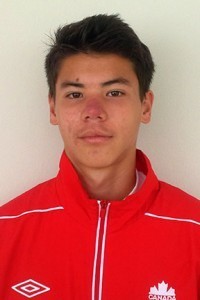
Kadin Chung
Maybe it’s the new format — which makes it much more difficult for Canada to qualify for the U-17 World Cup than in he past. Maybe it’s the fact that the national U-20 team flamed out so spectacularly in its recent attempt to qualify for its age group’s World Cup. But there’s no denying that the Canadian sentiment towards this crop of U-17s is more muted than past years. There’s no chatter of who’s going to be the next Great Canadian Hope.But, on Saturday night in Honduras, this group survived its first challenge of the CONCACAF U-17 Championships, with a 3-1 win over Haiti. Duwayne Ewart, Matthew Baldisimo and Kadin Chung got the goals.
For Canada, with the new format, there is no margin for error in matches against the so-called minnows. In years past, the round-robin would often see one ranked CONCACAF nation paired up with two lesser lights. Win the group, and you were well on your way to a U-17 World Cup berth or at least a playoff for a U-17 World Cup spot. ?
But, wisely, CONCACAF changed the format. For the smaller nations, sending a team to play just two games made little financial or developmental sense. You arrived and were eliminated in the blink of an eye. So, the new format sees the field split into two groups of six. Each team is guaranteed five matches in a compressed amount of time; so coaches are forced to utilize most of their squads — and, so, more players will get minutes of international action.
For Canada to qualify for the U-17 World Cup, it needs to either win its group (an automatic spot) or finish second or third in the pool and then win a crossover playoff match against a second- or third-placed team from the other six-team section. Canada’s group also includes Mexico (ulp), Costa Rica (ulp) and Panama (ulp).To have a chance to get to the World Cup, Canada must finish ahead of one of those three teams. And that means there’s no margin for error when playing the two minnows — Haiti and Saint Lucia
The Haiti game was mission accomplished for Canada; though, with all due respect to the Caribbean side, a two-goal margin might not be much help Canada in the goal-difference section. In a comparable first-round match, Costa Rica beat Saint Lucia by four. (Panama lost to the Mexicans by a 3-1 count).
“With this new format, I think it’s critical that we get three points in our first game,” Canadian coach Sean Fleming said after the match. “I give Haiti a lot of credit. I know we can see some of their players were struggling physically with the conditions but the character they showed, I really give great respect to them. I liked some of the things our players did and being the first game, there are some things we have to get better at but overall, I’m quite pleased with the start to the tournament.”
Costa Rica is the next opponent, and that game will give us a better sense of just where this Canadian side stands.
READ THE NEW ISSUE OF PLASTIC PITCH! CANADIAN SOCCER. CANADIAN STORIES. OUT NOW FOR APPLE and ANDROID DEVICES.
Or, visit the PLASTIC PITCH SHOPIFY STORE!
February 25, 2015
Sanna’s advice helped steer Sainey Nyassi towards FC Edmonton
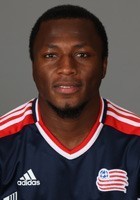
Sainey Nyassi
Last year, Sanna Nyassi was a member of the Montreal Impact, and started both legs of the Amway Canadian Championship semifinal against FC Edmonton. A last-gasp Patrice Bernier penalty kick allowed Montreal to snatch that series from the Eddies.But the Eddies’ play over those 180 minutes made a lasting impression on the Gambian player, who has since moved on to the San Jose Earthquakes. So, when his twin brother, Sainey, was looking for a club, Sanna gave the Eddies a glowing review.
Sainey decided to take up the Eddies’ offer and joined the NASL side after spending the 2014 season with RoPS of the Finnish League. Before that, Sainey had played 118 MLS matches with New England and D.C. United.
“My brother played here in Edmonton with Montreal,” Sainey said after the Eddies’ training camp session on Wednesday. “He said he was impressed by their quality, that they were a good team. He said that they were very lucky to win the last time they played.”
And, so, after a year in Europe, Sainey is back in North America, where he feels more comfortable.
“For me, it feels like I am back in the mix. I’ve had some great talks with the coach (Colin Miller), I know what I’m here for. I’m here to help this team win. I know he wants me to help this team win games. And when I got here, I was very impressed by the quality of the players. There are many players here on this team who are MLS-calibre. I used to think there was a big difference in quality between MLS and NASL; but, outside of a few things, I can see the difference between the two leagues is not that great.”
Miller said additions like Nyassi — a speedster who will help provide for the strikers — and Icelandic winger Oskar Orn Hauksson will boost the team’s offence, without forcing an overhaul at the striker position. Frank Jonke, who struggled with a concussion last season and trained for the first time on Wednesday, Daryl Fordyce and Tomi Ameobi should benefit from improved service and support.
Nyassi said the reason he didn’t stay in Finland was that it was hard to play in a country where soccer is rated so far below hockey in its culture.(OK, I know what you’re gonna say here — “And he decided to come to CANADA?” I will make allowance for that right now.)
“The quality of the play is very good, it’s a very good league. But there are not a lot fans, because soccer is not as popular as hockey or basketball there.”
And does Sainey dream of rejoining Sanna in MLS? Yes, but it’s not his focus.
“Sure, the reason I came back is to get myself in the mix. I’d certainly like to play again in MLS one day. But that is not my focus right now. I am focused on this league and this team.”
READ THE NEW ISSUE OF PLASTIC PITCH! CANADIAN SOCCER. CANADIAN STORIES. OUT NOW FOR APPLE and ANDROID DEVICES.
Or, visit the PLASTIC PITCH SHOPIFY STORE!
Another Canadian in NASL: Attakora inks deal with San Antonio
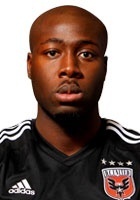
Nana Attakora
Nana Attakora has left Unattached FC behind.The Canadian defender, who has spent time with Toronto FC, the San Jose Earthquakes and, more recently, D.C. United, is now a member of the San Antonio Scorpions. The NASL side announced the deal Wednesday, killing rumours that had linked Attakora to the New York Cosmos.
Attakora had been on trial with the Cosmos.
“Attakora is a current, experienced, Canadian National Team defender with 70 appearances in Major League Soccer,” said Scorpions coach Alen Marcina in a release issued by the club. “He’s competed in CONCACAF Champions League while playing for Toronto FC and D.C. United. He is a powerful, fast defender that brings even more stability to our backline.”
Last season, former Toronto FC player of the year Adrian Cann helped the Scorpions to the NASL championship, though injuries kept him out of the title game. With a Canadian coach in Marcina, Attakora will likely get the chance to help re-fire a career that had seen him relegated to being a depth player in MLS.
READ THE NEW ISSUE OF PLASTIC PITCH! CANADIAN SOCCER. CANADIAN STORIES. OUT NOW FOR APPLE and ANDROID DEVICES.
Or, visit the PLASTIC PITCH SHOPIFY STORE!
February 24, 2015
Midfielder Granitto had options in Serie A and MLS, but chose FC Edmonton
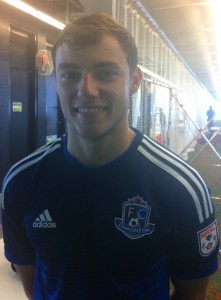
Tomas Granitto
In the autumn of 2014, Tomas Granitto had options. He had a pre-contract offer from Palermo of Italy’s Serie A. He had just auditioned for FC Dallas of MLS, and had an offer to attend training camp with that team in 2015.But he also had interest from FC Edmonton of NASL. And, he decided to go that route.
“I knew that this would be the best choice for me,” says the central midfielder after the Eddies wrap up their second-day of on-field training at the Commonwealth Recreation Centre. “I knew that I could come in here and help the team out right away, to be a great support for the team.”
In 2013, El Salvador beat Australia in the group stage of the U-20 World Cup. Granitto was named man of the match. And it was El Salvador’s first World Cup win at any age level — that game announced to the world that the young central midfielder had arrived.
“It was a great feeling to be part of that first win in an actual World Cup, and an honour to be the man of the match of that game,” he says.
So, how did FCE coach Colin Miller get in the offer that won Granitto over? The first thing he had to do was sift through the many audition videos he gets from player agents. Most of them get cursory looks. But he was struck when he saw Granitto in action.
“We get inundated with DVDs from every agent in the world,” says FC Edmonton’s coach. “Every agent in the world has a player he believes is the next Pele, next Beckenbauer. Everyone is Lionel Messi. But as soon as a I saw this player (Granitto), he reminded me of me as a player. He’s a midfielder who can see a pass, he’s a player who is physically fit and can add some steel to the central midfield.”
Granitto comes from a sporting family. He was born in El Salvador to Argentine parents. His father, Gustavo, ran a tennis academy and had been assigned by the International Tennis Federation to Central America to help develop the game there. Granitto lived in El Salvador till he was five, then his family moved to the United States. Granitto would excel at soccer and would play his way onto the roster at Florida Gulf Coast University, and helped that team to its first-ever NCAA tournament appearance.
But it was with the El Salvadorean program where he really caught the attention of scouts, as he was one of the highlights of his birth country’s run at the 2013 U-20 World Cup.
Granitto also holds an Argentine passport — and, because he has U.S. residency, he counts as a domestic on the FCE roster.
And, of course, he loves the game of tennis.
“I’d say it’s my next favourite sport after soccer,” he says. “It has stuck with me, and I love to watch it, especially the Grand Slam events. My favourite player? Roger Federer, to me he is the perfect example of class that a professional athlete needs to have.”
And he says his knowledge and love of tennis has helped make him a better footballer.
“Tennis, it is such a tough game, you have to be so strong mentally. It’s up to you, you have to be able to pick yourself up in the game. And that attitude really helps with my soccer.”
JONKE STILL OUT: Canadian striker Frank Jonke, who missed a significant chunk of the 2014 fall season because of a concussion, hasn’t been on the field for the first two days of Eddies’ training camp.
The issue isn’t his head, though — it’s his stomach.
Miller confirmed that Jonke is now free of any concussion-related symptoms, but has developed a stomach illness which makes it agonizingly painful to eat.
“He’s lost quite a bit of weight,” said the coach.
The illness has now been diagnosed and is being treated, and Miller feels Jonke will soon be cleared to join the team on the field.
READ THE NEW ISSUE OF PLASTIC PITCH! CANADIAN SOCCER. CANADIAN STORIES. OUT NOW FOR APPLE and ANDROID DEVICES.
Or, visit the PLASTIC PITCH SHOPIFY STORE!
February 23, 2015
Now with FCE, Hauksson looks forward to the challenge of North American football
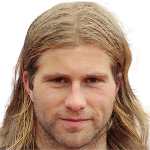
Oskar Orn Hauksson
It’s not hard to pick out Oskar Orn Hauksson out of a crowd of FC Edmonton players wearing the team’s brand new blue and black training tops. He’s got his long blond locks tied into a knot atop his head, in a design that makes you wonder if there’s such a thing as a viking-samurai crossover.While the long blond locks, startings of a beard and ,the Icelandic heritage might get you thinking “The Mighty Thor” right out of the gate, the veteran hopes that his crosses and ability to pick out a pass will be what makes him stick in the minds of Eddies fans.
While Hauksson has only been in Edmonton a short time — he likes what he sees. On loan from KR Reykjavik, he wants to establish himself away from his homeland. And playing in the NASL offered that chance to diversify his career.
“I’ve been in Iceland a long time, and I’ve won all you can win over there,” Hauksson says after the first formal training session of the Eddies’ 2015 training camp comes to a close. “I’ve played in Europe, too. I wanted a new challenge. I know that soccer is on the rise in North America. My agent came up with it, and we talked to Colin (FC Edmonton head coach Colin Miller) and we did the deal.”
But, before the deal was signed, Hauksson spoke to Tomi Ameobi. The Eddies’ striker made his NASL debut in 2014 but, before that, played against Hauksson in the Icelandic league. So, Hauksson sounded Ameobi out; and the reviews for FCE and the NASL were positive.
“He said it was a good level of football, that the competition is good. And, what I have seen is very good so far,” says Hauksson.
Because he’s played European games in warm weather, the thought of having to play in Texas or Florida summer heat and humidity doesn’t faze Hauksson. And what can FCE supporters expect to see? A player who can spend time on either wing. But, with NASL Best XI man Lance Laing on the left, it’s easier to imagine Hauksson getting time on the right side.
“I’m a creative player, who can deliver the ball from the wings,” says Hauksson. “From the right, I can take the ball inside and shoot or from the left I can deliver crosses. I can play on either side. What I will do will be Colin’s choice.”
READ THE NEW ISSUE OF PLASTIC PITCH! CANADIAN SOCCER. CANADIAN STORIES. OUT NOW FOR APPLE and ANDROID DEVICES.
Or, visit the PLASTIC PITCH SHOPIFY STORE!
Ex-TFC and Bolton Wanderer Johann Smith begins trial with FC Edmonton
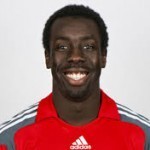
Johann Smith
The New York Cosmos played friendlies in Hong Kong to help celebrate the Lunar New Year. The Jacksonville Armada played a much ballyhooed preseason friendly against Major League Soccer’s Philadelphia Union. Minnesota United is training. The Tampa Bay Rowdies are playing games.It feels like every other team in NASL has been in camp for weeks, yet FC Edmonton just began its on-field sessions on Monday at Commonwealth Stadium.
So, are the Eddies behind the rest of the NASL when it comes to preparations for the 2015 season? Coach Colin Miller doesn’t think so. He says that his players came into camp in shape — and there’s a risk of starting camp too early and burning players out.
“In the past, we’ve had an eight-week preseason, and the players complained about it,” said Miller.
This year, the players and staff will have just over a month to get ready for the April 4 season opener at Jacksonville. The Eddies will travel to Florida in late March and play all three of that state’s NASL teams in a series of friendlies before the games begin for real.
Miller said the reason so many of the other teams got off to early starts is simple.
“They want to accommodate the MLS schedule so they can schedule friendlies against MLS clubs,” he said. Because MLS is set (barring a labour interruption) to kick off in March, a month ahead of NASL, MLS camps opened in January. So, Miller believes NASL clubs are willing to add weeks to their training camps just to they can synch up with MLS clubs.
The Eddies made several additions heading into camp; El Salvadorean midfielder Tomas Granitto, Icelandic winger Oskar Orn Hauksson and former MLSer Sainey Nyassi were added to the roster. Former Minnesota United keeper Matt Van Oekel was also signed.
And, former Toronto FC forward Johann Smith will be in the Eddies’ camp for the next three weeks. The American speedster played for the Reds in 2008 and ’09, and was also once part of Bolton Wanderers’ roster.
“He has a terrific attitude,” says Miller. “And he runs faster than I can drive my car. We are going to give him an opportunity; he also had English Premier League experience.”
As well, Canadian Hanson Boakai is in camp, after spending several weeks in Spain training with Deportivo La Coruna. FC Edmonton says Boakai’s time there was strictly as a training /fitness exercise, as he recovered from injuries and the CONCACAF U-20 World Cup qualifiers.
Boakai said he was nursing injuries throughout the U-20s, and he couldn’t risk starting games for fear of turning minor problems into major issues. At the CONCACAF tournament in Jamaica, he became coach Rob Gale’s super sub, but wasn’t used in the loss that eventually eliminated Canada from contention.
Boakai says training in Spain was a lot different than his experiences in Germany. In 2014, the teenager trained with Fortuna Dusseldorf.
“It was good for me, the Spanish play more my kind of style,” said Boakai. “In Germany it was a lot more physical. In Spain, it’s about playing with the ball in tight spaces, it’s about keeping the ball.”
READ THE NEW ISSUE OF PLASTIC PITCH! ENTER NOW TO WIN $200 WORTH OF UMBRO CANADA MERCHANDISE! (Deadline: Feb. 28) OUT NOW FOR APPLE and ANDROID DEVICES.
Or, visit the PLASTIC PITCH SHOPIFY STORE!
February 13, 2015
Why the MLS-USL affiliation makes the free-agency issue even more urgent
 When the now-expired Collective Bargaining Agreement was signed between Major League Soccer and its Players’ Union in 2010, the league didn’t have an established farm- or minor- or developmental league system.
When the now-expired Collective Bargaining Agreement was signed between Major League Soccer and its Players’ Union in 2010, the league didn’t have an established farm- or minor- or developmental league system.
Sure, MLS teams could loan out players or sometimes make deals to have them spend time in NASL. But, in 2010, other than reserve-team games, there was no entrenched system that could see a team send an under-contract MLS player to an affiliated lower-league team.
But, in 2015, MLS has an agreement in place with USL; the final dominoes to fall were the Canadian teams, now that the Canadian Soccer Association has granted sanctions to USL franchises in Montreal, Toronto and Vancouver — albeit with tough quotas on how many Canadians those teams must put on the field.
It really doesn’t matter if you call the USL a developmental league, a league that deserves to be recognized as second division across North America, a farm league or a minor league. The fact is, all MLS teams carry the power to assign at least some of their players to their USL affiliates, much like Canadian forward Kyle Porter spent most of the 2014 season in Richmond and after being sent there by D.C. United.
Down the road, it would be hard to imagine an MLS without two-way contracts, like we see in the National Hockey League. A two-way contract is a deal which calls for a player to make one salary figure if he plays at the major-league level, and another salary if he’s at the minor-league level.
And it’s at the USL level where the issue of free agency — the divide that separates the union and MLS brass — might be most important. If players can be “parked” in the lower division for the lives of their contracts, including team options, then it’s hard to call USL anything else but a farm system. But, if players who are with MLS teams but don’t get the chance at first-team MLS football are offered the chance to move on, then we can argue that truly, USL is a system that puts the development of the player, first.
How so?
Let’s look at the NHL, where every team is affiliated with an AHL franchise. The NHL CBA recognizes that an AHL player in a stacked Chicago Blackhawks system might get the chance to play at the NHL level (and make more money) because he could be good enough to play for the Oilers or the Hurricanes or, ahem, the Leafs.
So, the NHL CBA has Group 6 free agents. Basically, any player who has more than three seasons of pro experience (and that can be the major Euro leagues and/or the AHL or a combination of time spent in multiple leagues), and hasn’t played 80 NHL games, can be an unrestricted free agent at age 25.
That rule isn’t in place about salaries. It’s about giving the players chances to establish themselves somewhere else if they’re caught on treadmills with their current franchises.
As well, there are mechanisms in place to ensure that players who are designated for the minors a certain number of times — or who are veterans — must clear waivers. This ensures that a veteran player can’t simply be sent down to mitigate a cap hit or that a player simply can’t be bounced back and forth between the NHL and AHL.
If MLS was to grant free agency to players who had a specified amount of years of professional service but had only played a low threshold of first-team matches, it wouldn’t burn the salary cap. These would be players who would only be making five digits in the current MLS salary structure. It’s about freedom of opportunity, not cost. Because, as much as we talk about the need to develop players, at some point “developmental” soccer becomes a prison.
I’d argue that the MLS threshold would need to be a) fewer games and b) at a lower age. At 25, a guy who gets a shot could still be looking at 10 years of professional hockey, barring injuries. But, for a soccer player, 25 is old. In a lot of cases, too old for a team to take a chance on. So, since 23 is the magic Olympic qualifying age, I’d suggest that be the cut-off age. If you aren’t playing MLS first-team soccer by age 23, and if you’ve been under contract for at least three years (again, because of the accelerated nature of the soccer career, maybe two years pro service would be fairer to the players), a team can’t simply pick up the options and send you back to USL or have you rot on the bench. You should be allowed to call around.
Because, the trap is that USL could become a place to stash players making low salaries on contracts laden with team options. That is, the team decides whether or not to pick up the contract, and the salary raises from option to option are negligible.
Remember that a player sees his mid 20s as his earning years. He needs to make money in order to make up for the fact that he might have left school early and closed himself off from other career options. He might have to be prepared to support a family and go back to school or be unemployed for a while after his career ends. So, you don’t look at player earnings as a by-year thing; you look at earnings over a career.
And this is why free agency continues to be such a major hill for the players’ union. But, the addition of USL to the mix makes for an even more colourful debate.
READ THE NEW ISSUE OF PLASTIC PITCH! CANADIAN SOCCER. CANADIAN STORIES. OUT NOW FOR APPLE and ANDROID DEVICES.
Or, visit the PLASTIC PITCH SHOPIFY STORE!
February 10, 2015
FC Edmonton reaches an agreement with Sainey Nyassi
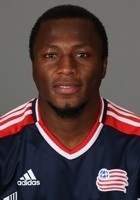
Sainey Nyassi
FC Edmonton announced that it has come to contract terms with Gambian attacking midfielder Sainey Nyassi.Nyassi has represented his native Gambia at youth and senior levels, but he has an American green card so he doesn’t count against the international roster limit. FCE is currently maxed out with seven international spots on the roster.
Nyassi played 104 MLS matches with the New England Revolution, and scored eight goals. In 2013, he made 14 appearances for D.C. United and didn’t get a goal. He spent last season playing in Finland. What Nyassi can briong to the team is his pace; Nyassi will offer speed either coming up the middle or on the wing.
Sanna Nyassi, Sainey’s twin brother, is more familiar to Canadian soccer fans, as he made 54 appearances with the Montreal Impact — scoring eight goals in his time in Quebec.
“I am excited about Sainey coming to the squad,” said FC Edmonton’s head coach Colin Miller in a release issued by the club. “He’s had a good career in MLS and he’s attack-minded and has great pace. He’ll be a great addition for us in our attacking options and I think he’ll be a great asset to our team.”
The Eddies have made four major off-season signings: Nyassi, Icelandic midfielder Oskar Orn Hauksson, El Salvadorean midfielder Tomas Granitto and American goalkeeper Matt Van Oekel. While many of the other NASL sides have begun their training camps, the Eddies’ players don’t have to report till Feb. 18. The training sessions will begin a few days later.
READ THE NEW ISSUE OF PLASTIC PITCH! CANADIAN SOCCER. CANADIAN STORIES. OUT NOW FOR APPLE and ANDROID DEVICES.
Or, visit the PLASTIC PITCH SHOPIFY STORE!




